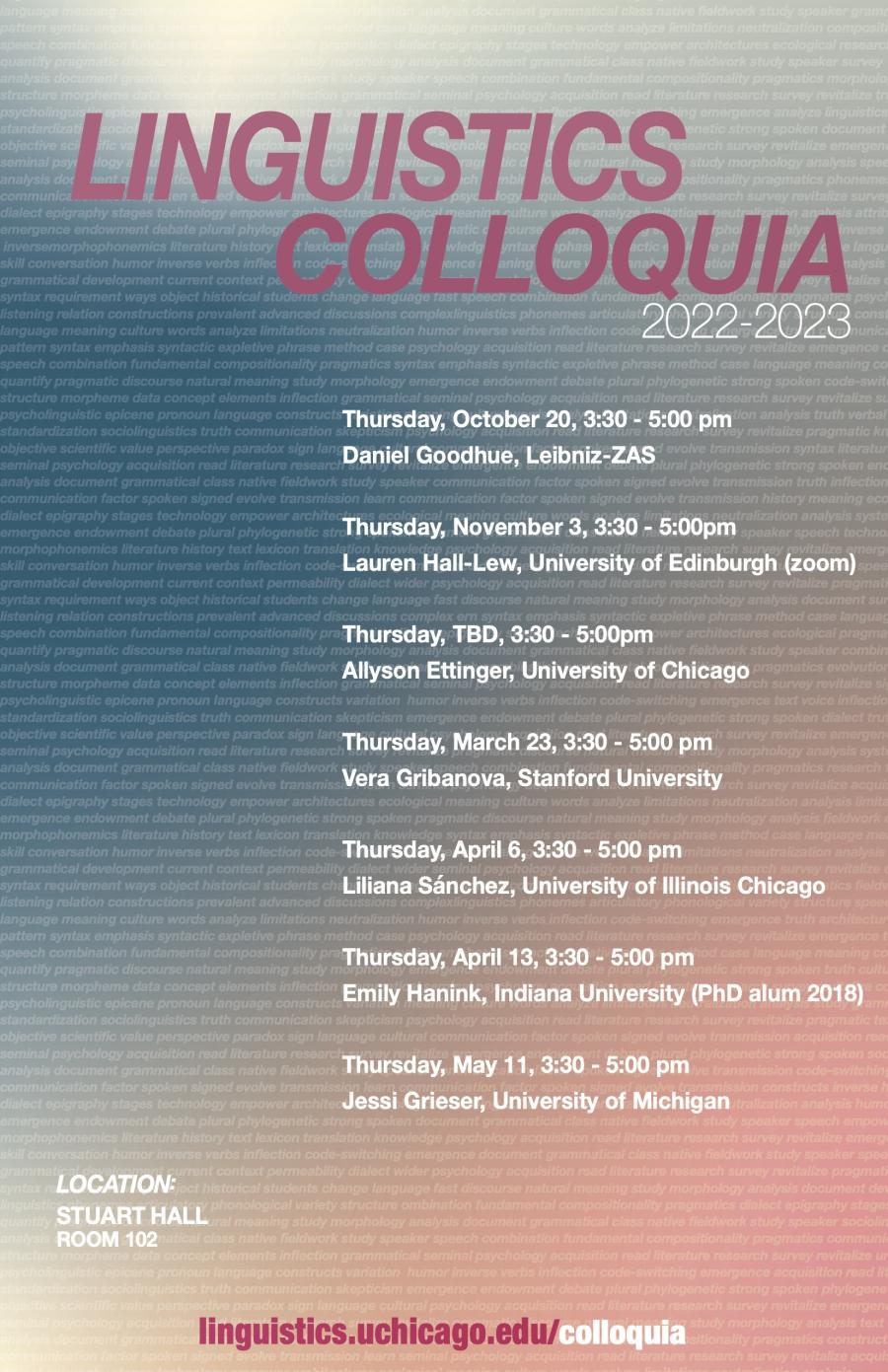Thursday, March 23, 3:30 - 5:00pm
Vera Gribanova, Stanford University
Stuart Hall, Room 102
On the sources of case (dis-)connectivity in two types of Russian TP ellipsis
Vera Gribanova
Stanford University
Discussions of the identity relation in constituent ellipsis licensing often take for granted, either explicitly or implicitly, the idea that the identity relation in ellipsis ought to be uniform, and applicable across different ellipsis configurations and languages. Recent investigations of this relation — Rudin 2019, Kroll 2019, Anand, Hardt, and McCloskey 2022, Stigliano 2022 — have provided novel evidence and arguments in support of the view that the domain of application of the identity relation is not always coextensive with the domain of the ellipsis itself. For example, although the prevailing view of English sluicing as TP ellipsis historically took the domain of the identity relation to likewise be the TP (Merchant 2001), one of the main findings of the UCSC sluicing dataset is that material above the level of vP — e.g. tense/finiteness, modality, and polarity — can undergo felicitous mismatches. Generalizing beyond English sluicing, this raises the question of whether the domain of ellipsis identity must be a proper subset of the domain of ellipsis itself, or if the specific size of the domain relevant for the identity relation may be variable across languages and ellipsis configurations.
In this talk, I present an investigation of some asymmetries in how case connectivity is enforced in two types of Russian clausal (TP) ellipsis — contrastive polarity ellipsis and fragment answers — and develop an analysis explaining why these asymmetries take the shape that they do. The case study leverages the availability of a well-known case alternation between structural (nominative/accusative) case and genitive case under negation. The first asymmetry is that case connectivity on remnants of these two ellipsis types is enforced fully only in fragment answers, but not in contrastive polarity ellipsis, in which a contrastive DP is fronted to the left periphery, preceding a polar particle (‘yes’ or ‘no’). The second asymmetry is that in contrastive polarity ellipsis, genitive patients under negation in the antecedent can correspond to an accusative patient remnant outside the ellipsis site, but not the reverse. To capture these asymmetries, I develop an analysis of the system of licensing relations that connects the syntax of polarity expression, negative concord, and genitive of negation, and combine this with a formulation of the identity relation in ellipsis in which head-to-head identity between the elided material and the antecedent must be invoked (Saab 2008, 2010, 2022, Tanaka 2011, Rudin 2019, Stigliano 2022).
For the asymmetries between these two types of Russian TP ellipsis to emerge within an internally consistent system of analytical commitments, it is critical that the domain of evaluation for identity be larger than in English sluicing, and likely coextensive with the elided TP. This finding supports a view in which the domain of evaluation for the identity relation in ellipsis may vary across languages and ellipsis types. In the latter part of the talk, I point to a view of ellipsis licensing that can straightforwardly capture such variation, and which arises directly from unifying existing analyses (Aelbrecht 2010, Stigliano 2022) in which certain sub-parts of the ellipsis function — non-pronunciation, syntactic licensing, and the identity relation — can be either grouped together, or broken up across several distinct heads in the clausal spine.
References
Aelbrecht, Lobke. 2010. The syntactic licensing of ellipsis. John Benjamins.
Anand, Pranav, Daniel Hardt, and James McCloskey. To appear. The domain of formal matching in sluicing. Linguistic Inquiry.
Kroll. Margaret. 2019. Polarity reversals under sluicing. Semantics and Pragmatics 12.
Merchant, Jason. 2001. The Syntax of Silence: Sluicing, Islands, and the Theory of Ellipsis. Oxford: Oxford University Press.
Ross, John Robert. 1969. Guess who? In Proceedings of the 5th Annual Meeting of the Chicago Linguistic Society. Robert I. Binnick, Alice Davison, Georgia M. Green, and Jerry L. Morgan (eds.), 252–286.
Rudin, Deniz. 2019. Head-based syntactic identity in sluicing. Linguistic Inquiry 50 (2): 253–283.
Tanaka, Hidekazu. 2011. Syntactic identity and ellipsis. The Linguistic Review 28: 79–110.
Saab, Andrés. 2008. Hacia una teoría de la identidad parcial en las elipsis. PhD Dissertation, Universidad de Buenos Aires.
Saab, Andrés. 2010. Silent interactions: Spanish TP-ellipsis and the theory of island repair. Probus 22 (1): 73–116.
Saab, Andrés. 2022. Grammatical silences from syntax to morphology. A model for the timing of ellipsis. In The Derivational Timing of Ellipsis, ed. Güliz Günes and Anikó Lipták. Oxford: Oxford University Press.
Stigliano, Laura. 2022. The silence of syntax: A theory of ellipsis licensing and identity. PhD dissertation, University of Chicago.

